
Explosively pumped flux compression generator
Encyclopedia

Electromagnetic pulse
An electromagnetic pulse is a burst of electromagnetic radiation. The abrupt pulse of electromagnetic radiation usually results from certain types of high energy explosions, especially a nuclear explosion, or from a suddenly fluctuating magnetic field...
by compressing magnetic flux using high explosive.
An EPFCG can be used only once as a pulsed power supply since the device is physically destroyed during operation. An EPFCG package that could be easily carried by a person can produce pulses in the millions of ampere
Ampere
The ampere , often shortened to amp, is the SI unit of electric current and is one of the seven SI base units. It is named after André-Marie Ampère , French mathematician and physicist, considered the father of electrodynamics...
s and tens of terawatts, exceeding the power of a lightning
Lightning
Lightning is an atmospheric electrostatic discharge accompanied by thunder, which typically occurs during thunderstorms, and sometimes during volcanic eruptions or dust storms...
strike by orders of magnitude. They require a starting current
Electric current
Electric current is a flow of electric charge through a medium.This charge is typically carried by moving electrons in a conductor such as wire...
pulse to operate, usually supplied by capacitor
Capacitor
A capacitor is a passive two-terminal electrical component used to store energy in an electric field. The forms of practical capacitors vary widely, but all contain at least two electrical conductors separated by a dielectric ; for example, one common construction consists of metal foils separated...
s.
Explosively pumped flux compression generators are popular as power sources for electronic warfare
Electronic warfare
Electronic warfare refers to any action involving the use of the electromagnetic spectrum or directed energy to control the spectrum, attack an enemy, or impede enemy assaults via the spectrum. The purpose of electronic warfare is to deny the opponent the advantage of, and ensure friendly...
devices known as transient electromagnetic device
Electromagnetic pulse
An electromagnetic pulse is a burst of electromagnetic radiation. The abrupt pulse of electromagnetic radiation usually results from certain types of high energy explosions, especially a nuclear explosion, or from a suddenly fluctuating magnetic field...
s that generate an electromagnetic pulse without the costs and side effects of a nuclear weapon
Nuclear weapon
A nuclear weapon is an explosive device that derives its destructive force from nuclear reactions, either fission or a combination of fission and fusion. Both reactions release vast quantities of energy from relatively small amounts of matter. The first fission bomb test released the same amount...
. They also can be used to accelerate objects to extreme velocities, and compress objects to very high pressures and densities; this gives them a role as a physics research tool.
The first work on these generators was conducted by the VNIIEF center for nuclear research in Sarov
Sarov
Sarov is a closed town in Nizhny Novgorod Oblast, Russia. Until 1995 it was known as Kremlyov ., while from 1946 to 1991 it was called Arzamas-16 . The town is off limits to foreigners as it is the Russian center for nuclear research. Population: -History:The history of the town can be divided...
at the beginning of the 1950s followed by Los Alamos National Laboratory
Los Alamos National Laboratory
Los Alamos National Laboratory is a United States Department of Energy national laboratory, managed and operated by Los Alamos National Security , located in Los Alamos, New Mexico...
in the United States
United States
The United States of America is a federal constitutional republic comprising fifty states and a federal district...
.
History
At the start of the 1950s, the need for very short and powerful electrical pulses became evident to Soviet scientists conducting nuclear fusionNuclear fusion
Nuclear fusion is the process by which two or more atomic nuclei join together, or "fuse", to form a single heavier nucleus. This is usually accompanied by the release or absorption of large quantities of energy...
research. The Marx generator
Marx generator
A Marx generator is an electrical circuit first described by Erwin Otto Marx in 1924. Its purpose is to generate a high-voltage pulse. Marx generators are often used to simulate the effects of lightning on power line gear and aviation equipment....
, which stores energy in capacitors, was the only device capable at the time of producing such high power pulses. The prohibitive cost of the capacitors required to obtain the desired power motivated the search for a more economical device. The first magneto-explosive generators, which followed from the ideas of Andrei Sakharov
Andrei Sakharov
Andrei Dmitrievich Sakharov was a Soviet nuclear physicist, dissident and human rights activist. He earned renown as the designer of the Soviet Union's Third Idea, a codename for Soviet development of thermonuclear weapons. Sakharov was an advocate of civil liberties and civil reforms in the...
, were designed to fill this role.
Principles of function
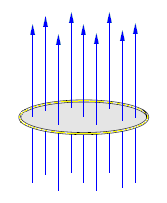
This flux conservation can be demonstrated from Maxwell's equations
Maxwell's equations
Maxwell's equations are a set of partial differential equations that, together with the Lorentz force law, form the foundation of classical electrodynamics, classical optics, and electric circuits. These fields in turn underlie modern electrical and communications technologies.Maxwell's equations...
. The most intuitive explanation of this conservation of enclosed flux follows from the principle that any change in an electromagnetic system provokes an effect in order to oppose the change. For this reason, reducing the area of the surface enclosed by a conductor, which would reduce the magnetic flux, results in the induction of current in the electrical conductor, which tends to return the enclosed flux to its original value. In magneto-explosive generators, this phenomenon is obtained by various techniques which depend on powerful explosives. The compression process allows the chemical energy of the explosives to be (partially) transformed into the energy of an intense magnetic field surrounded by a correspondingly large electric current.
Elementary description of flux compression
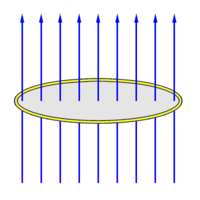
Electrical resistance
The electrical resistance of an electrical element is the opposition to the passage of an electric current through that element; the inverse quantity is electrical conductance, the ease at which an electric current passes. Electrical resistance shares some conceptual parallels with the mechanical...
). The nine field lines represent the magnetic flux threading the ring.
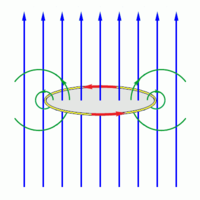
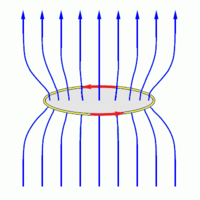
The various types of generators
The simple basic principle of flux compression can be applied in a variety of different ways. Soviet scientists at the VNIIEF in SarovSarov
Sarov is a closed town in Nizhny Novgorod Oblast, Russia. Until 1995 it was known as Kremlyov ., while from 1946 to 1991 it was called Arzamas-16 . The town is off limits to foreigners as it is the Russian center for nuclear research. Population: -History:The history of the town can be divided...
, pioneers in this domain, conceived of three different types of generators
- In the first type of generator (MK-1, 1951) developed by Robert Lyudaev, the magnetic flux produced by a wound conductor is confined to the interior of a hollow metallic tube surrounded by explosives, and submitted to a violent compression when the explosives are fired; a device of the same type was developed in the USAUnited StatesThe United States of America is a federal constitutional republic comprising fifty states and a federal district...
a dozen years later by C.M. (Max) FowlerClarence Max FowlerClarence Max Fowler was an American physicist who worked at Los Alamos between 1952 and 1996. His main contribution was on explosively pumped flux compression generators.-Career:...
's team at Los AlamosLos Alamos National LaboratoryLos Alamos National Laboratory is a United States Department of Energy national laboratory, managed and operated by Los Alamos National Security , located in Los Alamos, New Mexico...
; - The next type of generator (MK-2, 1952), the magnetic flux, confined between the windings of the external conductor and a central conductive tube filled with explosive, is compressed by the conical 'piston' created by the deformation of the central tube as the detonation wave travels across the device.
- A third type of generator (DEMG), developed by Vladimir Chernyshev, is cylindrical, and contains a stack of concave metallic disks, facing each other in pairs, to create hollow modules (with the number varying according to the desired power), and separated by explosives; each module functions as an independent generator.
Such generators can, if necessary, be utilised independently, or even assembled in a chain of successive stages: the energy produced by each generator is transferred to the next, which amplifies the pulse, and so on. For example, it is foreseen that the DEMG generator will be supplied by a MK-2 type generator.
Hollow tube generators
In the spring of 1952, R.Z. Lyudaev, E.A. Feoktistova, G.A. Tsyrkov, and A.A. Chvilevaundertook the first experiment with this type of generator, with the goal of obtaining a very high magnetic field.
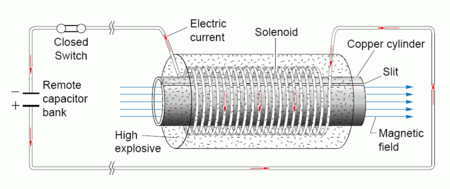
- A longitudinal magnetic field is produced inside a hollow metallic conductor, by discharging a bank of capacitors into the solenoid that surrounds the cylinder. To ensure a rapid penetration of the field in the cylinder, there is a slit in the cylinder, which closes rapidly as the cylinder deforms;
- The explosive charge placed around the tube is detonated in a manner that ensures that the compression of the cylinder commences when the current through the solenoid is at its maximum;
- The convergent cylindrical shock wave unleashed by the explosion produces a rapid contraction (greater than 1 km/s) of the central cylinder, compressing the magnetic field, and creating an inductive current, as per the explanation above (the speed of contraction permits, to first approximation, the neglect of Joule losses and the consideration of the cylinder as a perfect conductor).
The first experiments were able to attain magnetic fields of millions of gauss
Gauss (unit)
The gauss, abbreviated as G, is the cgs unit of measurement of a magnetic field B , named after the German mathematician and physicist Carl Friedrich Gauss. One gauss is defined as one maxwell per square centimeter; it equals 1 tesla...
(hundreds of tesla
Tesla (unit)
The tesla is the SI derived unit of magnetic field B . One tesla is equal to one weber per square meter, and it was defined in 1960 in honour of the inventor, physicist, and electrical engineer Nikola Tesla...
s, given an initial field of 30 kG (3 T which is in the free space "air" same as B/u0 = H --> 3 Vs/m^2 / 4pi10^-7 Vs/Am = 2.387x10^6 A/m so it is about 2.4 M A/m).
Helical generators
Helical generators were principally conceived to deliver an intense current to a load situated at a safe distance. They are frequently used as the first stage of a multi-stage generator, with the exit current used to generate a very intense magnetic field in a second generator.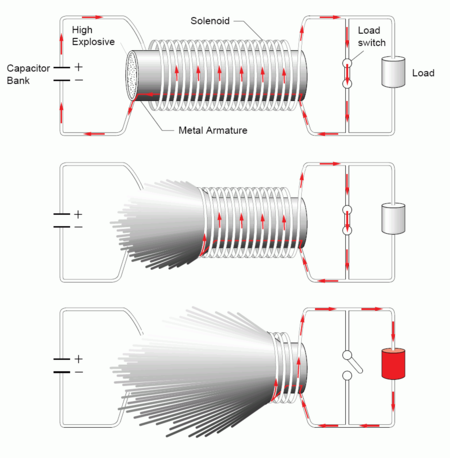
- A longitudinal magnetic field is produced in between a metallic conductor and a surrounding solenoid, by discharging a battery of capacitors into the solenoid;
- After the charge is ignited, a detonation wave propagates in the explosive charge placed in the interior of the central metallic tube (from left to right on the figure);
- Under the effect of the pressure of the detonation wave, the tube deforms and becomes a cone which contacts the helically wrapped coil, diminishing the number of turns not short-circuited, compressing the magnetic field and creating an inductive current;
- At the point of maximal flux compression, the load switch is opened, which then delivers the maximal current to the load.
The MK-2 generator is particularly interesting for the production of intense currents, up to 108 A
Ampere
The ampere , often shortened to amp, is the SI unit of electric current and is one of the seven SI base units. It is named after André-Marie Ampère , French mathematician and physicist, considered the father of electrodynamics...
(100 MA), as well as a very high energy magnetic field, as up to 20% of the explosive energy can be converted to magnetic energy, and the field strength can attain 2 × 106 gauss (200 T).
The practical realization of high performance MK-2 systems required the pursuit of fundamental studies by a large team of researchers; this was effectively achieved by 1956, following the production of the first MK-2 generator in 1952, and the achievement of currents over 100 megaamperes from 1953.
Disc generators
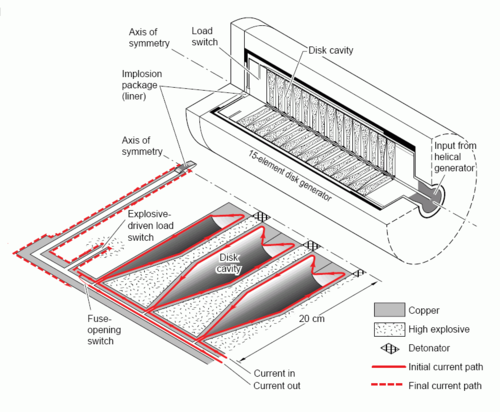
- Conductive metallic discs, assembled in facing pairs to create hollow modules having the form of a lined torusTorusIn geometry, a torus is a surface of revolution generated by revolving a circle in three dimensional space about an axis coplanar with the circle...
, with explosive packed between pairs of modules, are stacked inside a cylinder; the number of modules can vary according to the desired power (the figure shows a device of 15 modules), as well as the radius of the discs (of the order of 20 to 40 cm). - Current runs through the device, supplied by a MK-2 generator, and an intense magnetic field is created inside each module.
- When initiated, the explosion begins on the axis and propagates radially outwards, deforming the disc shaped protuberances with triangular section and pushing them away from the axis. The outward movement of this section of conductor plays the role of a piston.
- As the explosion proceeds, the magnetic field is compressed in the inside of each module by the conductive piston and the simultaneous drawing together of the inner faces, also creating an inductive current.
- As the induced current attains its maximum, the fuse opening switch fuses and the load switch simultaneously closes, allowing the current to be delivered to the load (the mechanism for the operation of the load switch is not explained in available documentation).
Systems using up to 25 modules have been developed at VNIIEF. Output of 100 MJ at 256 MA have been produced by a generator a metre in diameter composed of three modules.
See also
- Andrei SakharovAndrei SakharovAndrei Dmitrievich Sakharov was a Soviet nuclear physicist, dissident and human rights activist. He earned renown as the designer of the Soviet Union's Third Idea, a codename for Soviet development of thermonuclear weapons. Sakharov was an advocate of civil liberties and civil reforms in the...
- Clarence Max FowlerClarence Max FowlerClarence Max Fowler was an American physicist who worked at Los Alamos between 1952 and 1996. His main contribution was on explosively pumped flux compression generators.-Career:...
- Pulsed powerPulsed powerPulsed power is the term used to describe the science and technology of accumulating energy over a relatively long period of time and releasing it very quickly thus increasing the instantaneous power.-Overview:...
- Marx generatorMarx generatorA Marx generator is an electrical circuit first described by Erwin Otto Marx in 1924. Its purpose is to generate a high-voltage pulse. Marx generators are often used to simulate the effects of lightning on power line gear and aviation equipment....
- Los Alamos National LaboratoryLos Alamos National LaboratoryLos Alamos National Laboratory is a United States Department of Energy national laboratory, managed and operated by Los Alamos National Security , located in Los Alamos, New Mexico...
- Pinch (plasma physics)Pinch (plasma physics)A pinch is the compression of an electrically conducting filament by magnetic forces. The conductor is usually a plasma, but could also be a solid or liquid metal...
External links
- Scientific Collaborations Between Los Alamos and Arzamas-16 Using Explosive-Driven Flux Compression Generators
- An Introduction to Explosive Magnetic Flux Compression Generators
- Generation of Ultra-High Magnetic Fields for AGEX (LANL)
- Superpower explosive magnetic energy sources (V.K. Chernyshev, VNIIEF)
- High-Strain-Rate Experiments to Determine the Dynamic Yield Strength of Copper
- Magnetized target fusion — an ultra high energy approach in a unexplored parameter space

